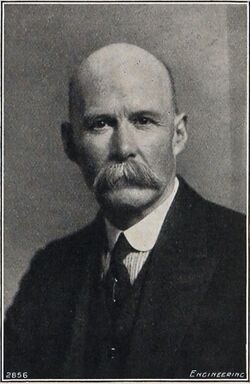Biography:Thomas Ernest Stanton
Sir Thomas Ernest Stanton CBE FRS (12 December 1865 - 30 August 1931) was a British mechanical engineer and a specialist in fluid dynamics and tribology. He was the first to construct a supersonic wind tunnel in 1921. The eponymous Stanton number is based on his research on the transfer of heat between metal surfaces through a separating thin layer of lubricating fluid.
Life
Stanton was born at Atherstone, Warwickshire to plumber Thomas and his wife Mary Ann Wagstaff. Educated at the local grammar school, he then apprenticed at Gimson and Co. engineers before going to Owens College, Manchester in 1887. He received a BSc in engineering in 1891 and worked for five years under Professor Osborne Reynolds. He then joined the University of Liverpool in 1896 and received a DSc in 1898 and became a professor the next year at University College, Bristol. He joined the National Physical Laboratory in 1901 and was involved in the testing of materials. He began wind tunnel studies in 1903 and by 1921 he had constructed a supersonic wind tunnel of 3 inch diameter going to 3.2 times the speed of sound for testing projectiles. This work was conducted secretly for the Britain's Ordnance Committee. It was here that he and Dorothy Marshall made studies on heat flow and found a relation between surface heat transfer rate, temperature difference and friction coefficients that is now known as Stanton number.[1] Stanton was elected Fellow of the Royal Society in 1914 and was knighted in 1928 for his contributions to the wartime effort.[2][3]
Stanton married Martha Grace Child in 1912 and they had two sons and a daughter, Hannah Margaret Stanton who was a leading anti-apartheid activist. He retired in 1930 and was living at Pevensy Bay where he was recovering after one surgery and preparing for another. His body was found, drowned, dressed in night clothes on 30 August 1931 off the beach near his family home.[4]
References
- ↑ Ackroyd, J.A.D. (2003). "The United Kingdom's contributions to the development of aeronautics. Part 4. The origins of the jet age". The Aeronautical Journal 107 (1067): 1–47. doi:10.1017/S0001924000011787.
- ↑ "Sir Thomas Stanton, C.B.E., F.R.S" (in en). Nature 128 (3229): 485–486. 1931. doi:10.1038/128485b0. ISSN 0028-0836. Bibcode: 1931Natur.128R.485..
- ↑ Stanton, T E (1931). "The James Forrest Lecture 1931. Engineering Research, by Sir Thomas Ernest Stanton, CBE. 5 May 1931." (in en). Minutes of the Proceedings of the Institution of Civil Engineers 232 (1931): 385–418. doi:10.1680/imotp.1931.13500. ISSN 1753-7843. https://www.icevirtuallibrary.com/doi/10.1680/imotp.1931.13500.
- ↑ McConnell, Anita (2004). "Oxford Dictionary of National Biography" (in en). Oxford Dictionary of National Biography. 1 (online ed.). Oxford University Press. doi:10.1093/ref:odnb/76286. ISBN 978-0-19-861412-8. http://www.oxforddnb.com/view/10.1093/ref:odnb/9780198614128.001.0001/odnb-9780198614128-e-76286. (Subscription or UK public library membership required.)
 |


